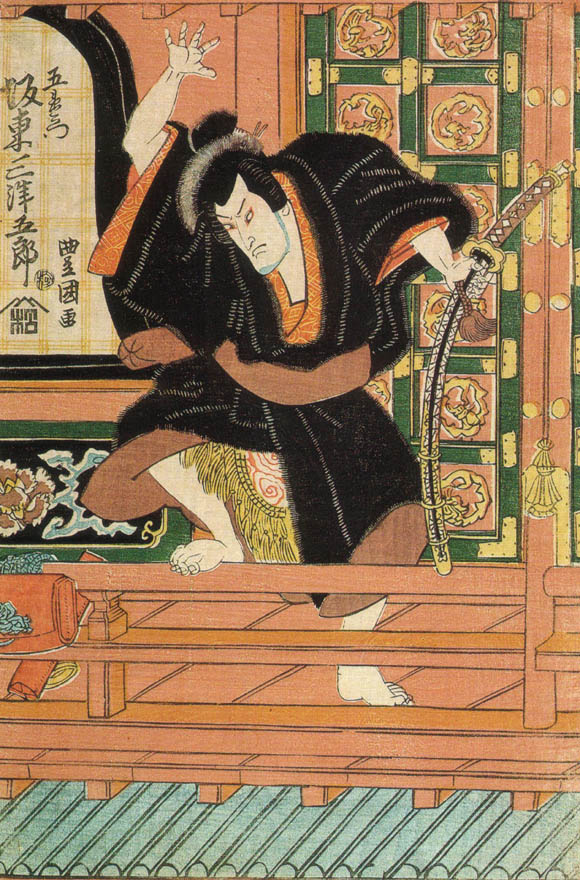- Bandō Mitsugorō III
Infobox actor
name = Bandō Mitsugorō III
三代目坂東三津五郎

imagesize = 250px
caption = Bandō Mitsugorō III playing the role ofIshikawa Goemon in the drama "Sanmon Gosan no Kiri ", which was staged in March 1820 at theNakamura-za (print made byUtagawa Toyokuni I ).
birthdate = 1775
location =Edo ,Japan
deathdate = death date|1831|12|27|df=y
deathplace =Edo ,Japan
height =
birthname =
othername = Bandō Minosuke I, Morita Kanjirō II, Bandō Mitahachi I, Yamatoya, Eiki no Oyagata, Shūka
homepage =
notable role = Tadanobu, Tomomori in "Yoshitsune Senbon Zakura ";Kumagai Naozane in "Ichi-no-Tani Futaba Gunki ";Matsuōmaru in "Sugawara Denju Tenarai Kagami "
academyawards =nihongo|Bandō Mitsugorō III|三代目 坂東 三津五郎|Sandaime Bandō Mitsugorō was a
Kabuki actor, one of the best "tachiyaku " (strong male role specialists) of the early 19th century. He is famous for a great many roles, and for his rivalry with theKamigata (Kyoto-Osaka) actorNakamuta Utaemon III .Names
Like most Kabuki actors, and many artists of his time, Mitsugorō bore a number of names. The third to bear the name
Bandō Mitsugorō , he was also called Bandō Minosuke I, Morita Kanjirō II and Bandō Mitahachi I earlier in his career. A member of theYamato-ya guild, he could be called by this name as well (see "yagō "). Finally, Mitsugorō was known in poetry circles as Shūka, and as he developed something of a reputation on the streets of Edo, he acquired the nickname "Eiki no Oyagata" (boss of the Eiki district).Lineage
Born into a family of actors, his parents were
Bandō Mitsugorō I andMorita Kanya VI 's daughter;Morita Kanya V andNakamura Jūsuke I were his grandfathers. Mitsugorō was adopted byMorita Kanya VIII , and was the son-in-law ofOgino Izaburō II . Later in his career, he adopted three sons,Morita Kanya X ,Morita Kanya XI andBandō Shūka I , and raised them in the theatre.Life and Career
Born in Edo in 1775, he made his stage debut at the age of three, at the
Morita-za , under the name Bandō Mitahachi I. The young actor took a number of different stage names over the course of his childhood, becoming the third Bandō Mitsugorō at theNakamura-za in 1799. His father died in 1782.As the 19th century began, Mitsugorō performed in a great number of plays and a myriad of roles, both male and female, at the Morita-za, Nakamura-za, and
Ichimura-za theatres. He came to be known for his dancing, and in particular for "hengemono ", dance plays in which he would quick-change through a number of roles. Though he played mostly women in these dance plays, he also frequently playedsumo wrestlers, and lead hero roles in some of the most popular and famous kabuki plays.In May 1815, he performed at the
Kawarazaki-za alongsideIwai Hanshirō V ,Matsumoto Kōshirō V andIchikawa Danjūrō VII , some of the most famous actors of the time. Over the years, he developed a rivalry with "kamigata" actor Nakamura Utaemon III, also known as Shikan. These types of rivalries were not uncommon in the kabuki world, particularly between actors from Edo and Kamigata, but were likely friendly rivalries, promoted more by the fans and by the theatre managers, rather than by genuine ill-feelings on the parts of the actors towards one another. The two would perform together many times, both in Edo and in Kamigata, their rivalry extending over many years.Following a "hengemono" farewell performance, Mitsugorō left Edo and moved to
Osaka in December 1820. There, he performed primarily at theKado no Shibai , and frequently alongside Utaemon III. He also spent time performing inNagoya , and inKyoto at theKitagawa no Shibai , two cities where kabuki was far less prolific than in Edo and Osaka.Mitsugorō was ranked as "goku-jō-jō-kichi" (extreme-superior-superior-excellent) in the 1822 "
hyōbanki " (a popular publication ranking and evaluating actors and performances). In February of that year, his rivalry with Utaemon III reached its climax. Both actors simultaneously played the popular and powerful role of the thiefIshikawa Goemon at different theaters.He returned to Edo soon afterwards, marking the end of his 13-month stay in Kamigata. Over the following years, he would perform many more times, primarily at the Ichimura-za. In addition to sumo wrestler roles and "hengemono" quick-change dances, he played a number of different roles in "
Sugawara Denju Tenarai Kagami ", "Yoshitsune Senbon Zakura ", "Tōkaidō Yotsuya Kaidan", and other very popular and famous plays.His last performance was in November 1831, in "Matsu o Chikara Tomoe no Fuji Nami" at the Kawarazaki-za. The following month he fell ill and died.
References
* [http://kabuki21.com/mitsugoro3.php Bandō Mitsugorō III at Kabuki21.com]
Wikimedia Foundation. 2010.
